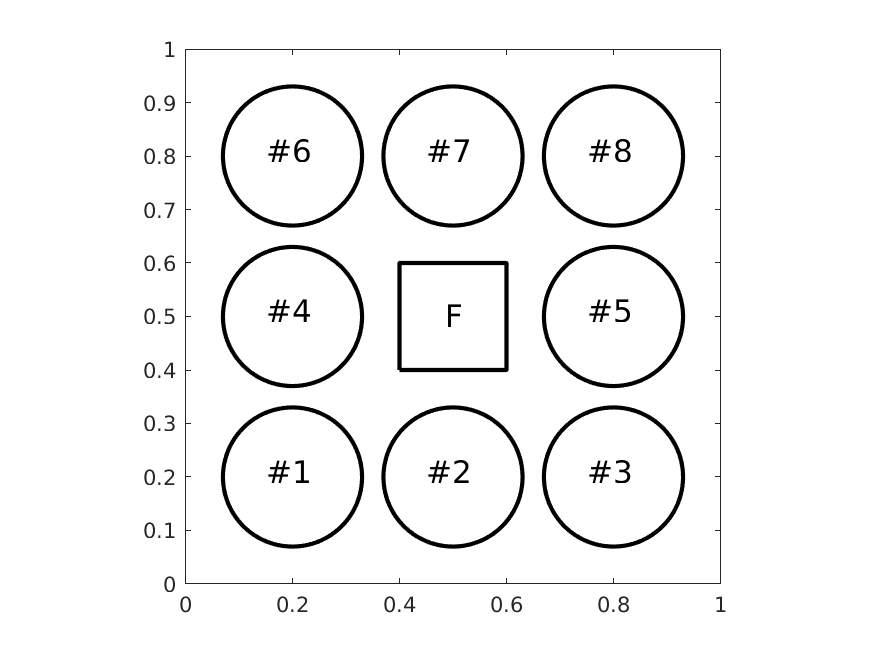The cookies model¶
Overview¶
This model implements the so-called ‘cookies problem’ or ‘cookies in the oven problem’ (see for reference [Bäck et al.,2011], [Ballani et al.,2015], [Kressner et al., 2011]), i.e., a simplified thermal equation in which the conductivity coefficient is uncertain in 8 circular subdomains (‘the cookies’), whereas it is known (and constant) in the remaining of the domain (‘the oven’). The PDE is solved by an isogeometric solver with maximum continuity splines, whose degree can be set by the user. See below for full description.
Run¶
docker run -it -p 4242:4242 linusseelinger/cookies-problem
Properties¶
Model |
Description |
|---|---|
forward |
Forward evaluation of the cookies model, all config options can be modified by the user (see below) |
benchmark |
Sets the config options for the forward UQ benchmark (see benchmark page) |
forward¶
Mapping |
Dimensions |
Description |
|---|---|---|
input |
[8] |
These values modify the conductivity coefficient in the 8 cookies, each of them must be greater than -1 (software does not check that input values are valid) |
output |
[1] |
The integral of the solution over the central subdomain (see definition of \(\Psi\) below) |
Feature |
Supported |
|---|---|
Evaluate |
True |
Gradient |
False |
ApplyJacobian |
False |
ApplyHessian |
False |
Config |
Type |
Default |
Description |
|---|---|---|---|
NumThreads |
integer |
1 |
Number of physical cores to be used by the solver |
BasisDegree |
integer |
4 |
Default degree of spline basis (must be a positive integer) |
Fidelity |
integer |
2 |
Controls the number of mesh elements (must be a positive integer, see below for details) |
Mount directories¶
Mount directory |
Purpose |
|---|---|
None |
Source code¶
Description¶

The model implements the version of the cookies problem in [Bäck et al.,2011], see also e.g. [Ballani et al.,2015], [Kressner et al., 2011] for slightly different versions. With reference to the computational domain \(D=[0,1]^2\) in the figure above, the cookies model consists in the thermal diffusion problem below, where \(\mathbf{y}\) are the uncertain parameters discussed in the following and \(\mathrm{x}\) are physical coordinates
with homogeneous Dirichlet boundary conditions and forcing term defined as
where \(F\) is the square \([0.4, 0.6]^2\). The 8 subdomains with uncertain diffusion coefficient (the cookies) are circles with radius 0.13 and the following center coordinates:
cookie |
1 |
2 |
3 |
4 |
5 |
6 |
7 |
8 |
|---|---|---|---|---|---|---|---|---|
x |
0.2 |
0.5 |
0.8 |
0.2 |
0.8 |
0.2 |
0.5 |
0.8 |
y |
0.2 |
0.2 |
0.2 |
0.5 |
0.5 |
0.8 |
0.8 |
0.8 |
The uncertain diffusion coefficient is defined as
where \(y_n>-1\) and
The output of the simulation is the integral of the solution over \(F\), i.e. \(\Psi = \int_F u(\mathrm{x}) d \mathrm{x}\)
The PDE is solved with an IGA solver (see e.g. [Da Vaiga et al., 2014]) that uses as basis splines of degree \(p\) (tunable by the user, default \(p=4\)) of maximal regularity, i.e. of continuity \(p-1\). The computational mesh is an \(N\times N\) quadrilateral mesh (cartesian product of knot lines) with square elements, with \(N=100 \times \mathrm{Fidelity}\). The implementation is done using the C++ library IGATools [Pauletti et al., 2015], available at gitlab.com/max.martinelli/igatools.